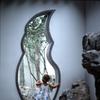High Museum receives significant gift of 19th-century American paintings and sculptures
- November 08, 2010 11:08
The High Museum of Art has received a major gift of 90 paintings and sculptures from the Atlanta-based West Foundation’s nineteenth-century American collection. The donated works include 49 paintings and 41 sculptures, establishing the High as a major resource for nineteenth-century American art. The gift enriches the High’s collection of American art with important works including landscapes by Frederic Edwin Church and Jasper Cropsey, portraits by Rembrandt Peale and William Sydney Mount, and sculptures by Hiram Powers and Chauncey Bradley Ives.
The newly-acquired paintings and sculptures will be on view within the permanent collection galleries on the second and third floors of the Stent Family Wing in the Atlanta musseum.
“Building a strong collection of American art has been an institutional priority for the High, and this recent gift has significantly diversified and enhanced our collection,” said Michael E. Shapiro, the High’s Nancy and Holcombe T. Green, Jr. Director. “As one of the most significant gifts to the department of American Art in the museum’s history, this collection distinguishes the High as a major center of neoclassical sculpture and nineteenth-century American Paintings.”
The West Foundation’s gift of neo-classical sculpture consists of 41 marble, plaster and bronze works, and was given in honor Gudmund Vigtel, Director Emeritus, and Michael E. Shapiro, the Nancy and Holcombe T. Green, Jr. Director of the High Museum.
The majority of the works are large-scale, neo-classical marbles executed between 1838 and 1887, including major works by William Wetmore Story, Hiram Powers, Edmonia Lewis, Harriet Hosmer, Thomas Ball, Randolph Rogers, and Thomas Crawford. The gift includes iconic objects that represent the chef d’oeuvre of an artist’s production, such as Hiram Powers’ “Proserpine,” Randolph Rogers’ “Nydia the Blind Flower Girl of Pompeii,” and Harriet Hosmer’s “The Sleeping Faun.”
Other highlights include nine marbles by Chauncey Bradley Ives, the largest single museum holdings of his sculpture; a plaster bust by one of America’s first artist-sculptors, William Rush, circa 1813; an 1894 casting of Frederick William MacMonnies’ bronze “Bacchante and Infant Faun.”
The 1878 version of “Cleopatra” by William Wetmore Story, of which an earlier version provided inspiration for author Nathaniel Hawthorne’s 1860 novel “The Marble Faun” as well as his "Medea" are joined by Edmonia Lewis’ “Columbus,” a rare carving depicting an explorer and a young Native American woman by the African-American sculptress.
Four Hudson River School paintings were given in honor of High Museum of Art Director Emeritus Gudmund Vigtel. These works by Frederic Edwin Church (“Twilight in the Catskills,” 1849), Sanford Robinson Gifford (“Mount Washington from the Saco River,” 1858), Louis Remy Mignot (“Sunset Winter,” 1862), and Thomas Worthington Whittredge (“Beach and Rocks,” ca. 1870-80) show a range of response to the American landscape, both cultivated and wild.
Vigtel, director of the High from 1963 to 1991, was instrumental in establishing the museum’s American collection and served as an advisor for the West Foundation Collection. Shapiro, whose scholarly work has included subjects on American bronze sculpture, has been an active advocate for the growth of the Museum’s sculpture collection.
In addition to the four Hudson River School paintings, 45 other paintings were also given in honor of Vigtel. This collection features twenty-four landscapes, nine genre paintings, eight figure and portrait paintings, and four still life paintings. All but three were executed before 1900, with the strongest concentration of works painted before 1880.
Highlights include two portraits by William Sydney Mount of Laetres and Laura Colton Chapman, dated 1833; one portrait by Rembrandt Peale of General Erastus Root, a major-general for the NY State militia, NY State senator and later a US Congressman, dated 1823; and an Italian landscape by Jasper Cropsey, titled “Ruins at Narni, Italy,” from 1875; and Charles Courtney Curran’s painting “Breakfast for Three."
“This gift of 19th Century American sculpture and paintings is a one of the most significant in the history of the High Museum,” said Gudmund Vigtel. “This adds immeasurably to the Museum’s collections which already include outstanding examples of American decorative arts and paintings of this period. I was involved in the selection of the works of art and remember keenly the collector’s excitement as new pieces added to the importance of this collection, ranking it among the finest in the South.”




















